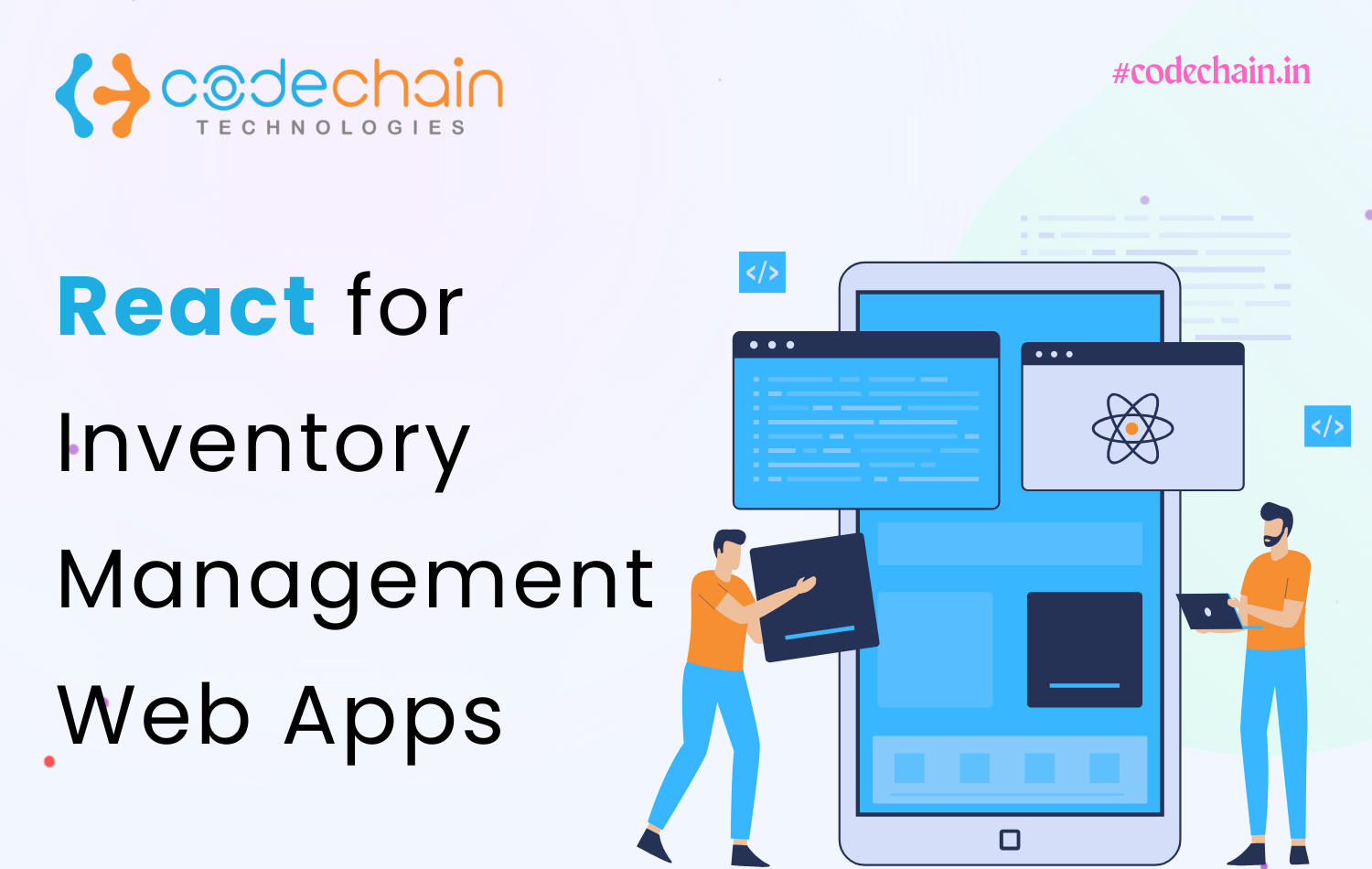
Inventory management is the backbone of modern businesses. From retail stores to large-scale warehouses, managing stock efficiently determines profitability and customer satisfaction. In today’s digital-first world, companies are rapidly shifting from manual systems to web-based inventory management apps. But a critical question arises: which technology is best suited to build such apps?
The answer is React.js. React is one of the most popular frameworks (technically, a JavaScript library) used for building dynamic, scalable, and user-friendly applications. Backed by Meta (Facebook) and a massive global developer community, React has become the go-to choice for startups and enterprises alike.
In this article, we’ll explain why React is the best choice for developing inventory management web apps, explore its top advantages, and show how CodeChain can help businesses leverage React to build powerful inventory solutions.
1. Speed and High Performance
One of the biggest requirements of an inventory management system is real-time updates. Imagine a warehouse where stock is constantly moving in and out — the app must update instantly without slowing down.
React makes this possible through its Virtual DOM (Document Object Model). Instead of reloading the entire web page whenever changes occur, React js only updates the specific components that have changed.
Example: When an item’s stock drops from 50 to 49, only that number updates instantly, without reloading the full dashboard.
This results in:
-
Faster loading times
-
Smoother user experience
-
Efficient handling of large databases
For businesses, this means employees can work faster without facing lag, even with thousands of product entries.
2. Scalability for Growing Businesses
Every business starts small, but growth brings complexity. An inventory management system must be flexible enough to handle:
-
More products
-
Multiple warehouses
-
Larger teams with different roles
React’s component-based architecture ensures scalability. Developers can easily add new features without affecting the existing system.
For example:
-
A small retailer might start with a single store stock system.
-
Later, they can add modules for multi-warehouse management or supplier tracking.
-
React allows these features to be added seamlessly.
This makes React future-proof for businesses that want to expand without rebuilding their entire software.
3. User-Friendly Interface
Inventory managers and employees often spend long hours on dashboards. A complex or slow interface reduces productivity.
React helps create highly interactive and responsive UIs. Features like:
-
Searchable product catalogs
-
Sort & filter options
-
Dynamic stock graphs and charts
-
Drag-and-drop management
All these make daily tasks easier for employees. A user-friendly inventory app also means lower training costs, since staff can adapt quickly.
4. Real-Time Updates with API Integration
Inventory management apps need to integrate with multiple systems — sales platforms, ERP, accounting, and supplier APIs.
React works seamlessly with Node.js, Express, and APIs to deliver real-time updates.
Example:
-
A product sells online → the inventory count reduces instantly in the React dashboard.
-
New stock arrives in the warehouse → managers see live updates without refreshing.
This real-time sync ensures businesses don’t face stockouts or overstocking.
5. Cross-Platform Compatibility
Businesses today want solutions that work on web and mobile. React makes this easier with React + React Native.
-
React (Web): For browser-based inventory apps
-
React Native (Mobile): For Android/iOS inventory apps
This means:
-
A warehouse employee can update stock via a mobile app.
-
A manager sitting in the office can track stock via a web dashboard.
Code once, deploy everywhere → saving development time and costs.
6. Strong Community and Ecosystem
React isn’t just a framework; it’s a thriving ecosystem. Businesses benefit because:
-
Regular updates keep the technology secure and reliable
-
Thousands of open-source libraries accelerate development
-
A massive developer community ensures easy troubleshooting
For long-term projects like inventory management systems, this community support is invaluable.
7. Enterprise-Grade Security and Maintenance
Inventory systems deal with sensitive business data. React provides:
-
Secure coding practices
-
Compatibility with advanced authentication (OAuth, JWT)
-
Role-based access controls
CodeChain ensures all apps built on React follow enterprise-grade security standards, making them safe for businesses handling critical operations.
8. Why CodeChain Recommends React
At CodeChain, we specialize in building custom inventory management systems using React. Our solutions are designed for:
-
Retail businesses that need product tracking and stock alerts
-
Warehouses managing multiple locations
-
E-commerce companies integrating with Shopify, WooCommerce, or custom platforms
-
Enterprises that need ERP + inventory modules
Features We Build with React:
-
Multi-location stock tracking
-
Barcode/QR code scanning integration
-
Supplier & purchase order management
-
Real-time analytics dashboards
-
Role-based access & user permissions
By combining React with Node.js, Express, and databases (MySQL, PostgreSQL, MongoDB), CodeChain delivers fast, scalable, and secure inventory solutions.
Conclusion
Choosing the right technology for your inventory management system is a critical business decision. React offers unmatched speed, scalability, cross-platform compatibility, and user-friendliness — making it the best framework for such apps.
With React, businesses can future-proof their inventory systems and ensure smooth operations, whether they manage 100 or 100,000 products.
If you’re looking to build a custom React-based inventory management web app, partner with CodeChain. Our expert developers create tailored solutions that align with your business goals and help you scale with confidence.
FAQ
Q1: Why is React suitable for inventory management web apps?
A1: React is fast, scalable, and component-based, making it ideal for dynamic inventory systems that require real-time updates.
Q2: Can React handle large-scale inventory systems?
A2: Yes, React’s modular architecture allows scaling easily, supporting multi-warehouse and enterprise-level inventory apps.
Q3: How does React improve user experience in inventory apps?
A3: React enables interactive dashboards, filters, and charts, providing a smooth and intuitive user experience for inventory managers.
Q4: Is React better than Angular or Vue for inventory management?
A4: React is lightweight, faster with Virtual DOM, and offers a vast ecosystem, making it more flexible and scalable for inventory apps.
Q5: Can React integrate with existing ERP or accounting software?
A5: Yes, React can seamlessly integrate with APIs, ERP, CRM, and accounting platforms for real-time inventory updates.
Q6: Can React-based apps be used on mobile devices?
A6: Absolutely. With React Native, inventory apps can run on Android and iOS devices while sharing code with the web app.
Q7: How secure are React inventory management applications?
A7: React apps can implement role-based access, secure authentication, and follow enterprise-grade security practices.
Q8: How does React handle real-time inventory updates?
A8: React works with APIs and WebSockets to update stock levels instantly across dashboards and devices.
Q9: Why should I choose CodeChain for React inventory apps?
A9: CodeChain specializes in custom React inventory solutions, offering scalable, secure, and user-friendly systems tailored to your business needs.
Q10: What is the cost of developing a React inventory management app?
A10: Costs vary based on features, integrations, and scale. CodeChain provides flexible packages to suit different business requirements.
